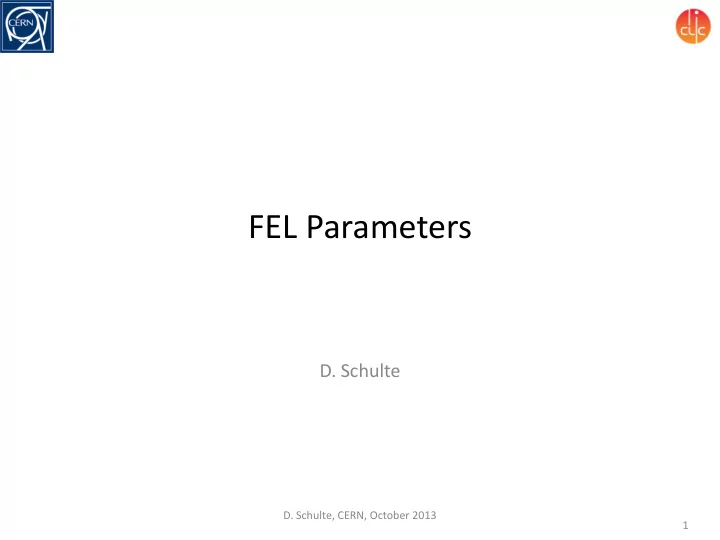

FEL Parameters D. Schulte D. Schulte, CERN, October 2013 1
Goals for Today • Define some baseline to work on – Energy goal – Will probably change later – But good to have something that you can criticise • Identify key questions for the other groups • Plan the integrated studies – Which studies can we perform before February? – What needs to be done afterwards? – What can be analytical? – Where are simulations required? – Who does what? • Exchange news D. Schulte, CERN, October 2013 2
Some News • We will develop an improved cost model for the klystron-based CLIC – Igor reviewed RF unit cost – Germana Riddone (and Philippe Lebrun) will review scaling of cost with numbers and cost of the linac – This can be applied nicely to the FEL • Some small differences exist (e.g. no damping) • Discussion with Marco Pedrozzi (PSI) indicated interest in O(15keV) photons (sub-Angstrøm) • We announced the activity in the CLIC project meeting D. Schulte, CERN, October 2013 3
Energy Target What is the energy range at the end of the linac? Is the maximum 0.07nm or 0.15nm? Are the bunch parameters the same for different energies? • lower energy implies lower gradient (or additional extraction points) • lower gradient changes the longitudinal and transverse wakefield effects • either need more margin in linac wakefields • or need to only change gradient in Linac3, but have to check longitudinal effects Need to understand operation at lower energy Who finds out which range is required? D. Schulte, CERN, October 2013 4
Repetition Rate and Bunch Number • Baseline is 50Hz, single bunch – For beam dynamics there is no difference to 500Hz, single bunch – For a few bunches per train, we have to check wakefield effects • Who will do this (in the linac group?)? – 500Hz, single bunch means higher heat load in the structures and puts constraints on the injector • The groups will address the issue – 500Hz, multi-bunch will not change much for the linac RF but might change things for the injectors • The groups will address the issue D. Schulte, CERN, October 2013 5
Longitudinal Dynamics E [MeV] E [MeV] E [GeV] Longitudinal design needs to be optimised keeping in mind the transverse effects • shorter bunches in linac2 reduce transverse wakefield effects Fast optimisation routine is required (Andrea did it for one structure) Some photon production model is needed (Avni did some work, but can we have something analytical?) Who can put together a fast longitudinal model? D. Schulte, CERN, October 2013 6
Transverse Dynamics Stability requires Transverse effects are also critical Have simplified model for the main linac (partly analytical) But need to also understand impact on photon production • Do we need a simulation? Do we have some analytic estimates? In the long run need full 6D simulation Who can check analytical estimates for photon production/rules of thumb? Who will start to integrate 6D simulations? 7 D. Schulte, CERN, October 2013
Preliminary Structure Choice? Preliminary a 1 /λ=0.15, a 2 /λ=0.1 d 1 /λ=0.9mm, d 2 /λ=1.7mm L=0.75m, G=65MV/m P in =41.8MW, τ =149.6ns 11 RF units 11 structure per unit? Cost=49.7 a.u. This structure has happened to be the cheapest Should we use it as a GUINEA-PIG to set up the simulations? 8 D. Schulte, CERN, October 2013
Electron linac RF unit layout based on the 2x ScandiNova solid state modulators existing (industrialized) RF sources (klystron 410 kV, 1.6 s flat top and modulator) 2x CPI klystrons 50 MW I. Syratchev, 1.5 s modified by me (Operated @45MW) X 5.2 100 (90) MW 1.5 s ~11 m, 16.3 cm TE01 transfer line ( RF =0.9) Inline RF distribution network TE01 90 0 bend Common vacuum network Preliminary 468 MW (418 MW) x 10 accelerating structures 150 ns @68.8MV/m (65MV/m) 46.8MV (41.8MW) input power 10 m, 7.5 active This unit should provide ~516 (488) MeV acceleration beam loading. Need 12 (12) RF units. Cost 51.7 a.u., 4% more than optimum D. Schulte, CERN, October 2013 9
More Examples for Basic Parameters Preliminary unit CLIC_502 Opt. Swiss Structures per RF unit 12 16 10 4 Klystrons per RF unit 2 2 2 1 Structure length m 0.23 0.23 0.75 1.98 a/lambda 0.145 0.145 0.125 Allowed gradient MV/m 100 80+ Operating gradient MV/m 77 67.5 65 27.5 Energy gain per RF unit MV 213 248 488 203 RF units needed 27 23 12 26 Total klystrons 54 46 24 26 Linac active length m 74 85 88 206 Cost estimate a.u. 76.2 71.5 51.7 D. Schulte, CERN, October 2013 10
Conclusion • Will try to put names to the tasks – Energy range choice – Energy range operation considerations – Simplified longitudinal model – Simplified transverse model/considerations – Complete longitudinal and transverse model D. Schulte, CERN, October 2013 11
Recommend
More recommend